The day has finally come! The new scope you’ve been wanting has finally arrived! This thing is going to be awesome on your favorite rifle! In a flurry of Allen wrenches, squinting eyes, and just a bit of thread locker spilled on the kitchen table, the optic is mounted up and your new rifle configuration is ready to hit the range.
It’s time to align the bullet’s point of impact with the point of aim through that sweet new scope—a process called “zeroing” the rifle. Depending on your approach, your equipment, and your expectations, zeroing can either be a satisfying or terribly frustrating experience. Scope University is in session, we’re going to teach you to zero like a hero!
How to Zero a Scope – Preparation
A successful sight-in session starts at home, not at the range. When mounting your scope, take your time and do it right. Be safe—make sure your rifle is unloaded, don’t even leave any ammunition lying around your work area at all. Unless you need to check for fitment issues with a bolt action rifle, just leave the bolt carrier group out of the rifle entirely to ensure safety.
Make sure the scope’s position is correct in relation to the placement of your eye when you take up a firing position. Shooting from the prone position tends to place your head further forward on the stock than shooting while sitting or upright, so some compromising may be involved for a rifle that will be shot from multiple positions.
If you are tilting your head or straining your neck to look through the scope, adjust its position in the mount. If the scope has an adjustable ocular, use it to make the scope’s reticle as sharp as possible for your eyes. You want a clear view through the optic from edge to edge, with no “shadows” dancing around while you are in a comfortable firing position behind the rifle.
If a major problem with the scope’s location is preventing this, you may have to research purchasing new rings or a different mount entirely.

You also need to ensure that the scope is vertically true and not “canted” or tilted left or right. A canted scope will cause your adjustments later to get very complicated. Windage adjustments will inadvertently bring the point of impact slightly up in one direction, then down again in the opposite direction.
Elevation adjustments will slightly affect the point of impact left and right. Zeroing a scope that behaves that way will make you shake your fist at the heavens, but it’s easy to avoid. There are several affordable tools available, from bubble levels to shims, that can eliminate this potential trouble as you mount your scope to the rifle.
Zeroing Hack: Get a brightly colored line of string or yarn and tie one end to a reasonably heavy object, like that old mil-spec stock you have lying around. Tie the other end to a tree branch or another object that lets the object hang freely straight down on the string.
You have just made a rudimentary plumb line. This is how the ancient Egyptians referenced true vertical lines as they built the pyramids, and it still works today. Looking through your scope, with your rifle unloaded and as vertically true as possible, compare your scope’s reticle with the vertical line of the string. If your scope isn’t straight up and down, you’ll be able to tell instantly, all for the price of a piece of string.
How to Zero a Scope – Bore Sighting
It’s time to hit the range! Bring some sight-in targets that incorporate 1” squares, a ruler or measuring tape, a calculator (there’s one in your cell phone already), binoculars or a spotting scope if you have one, and a method of fully supporting your rifle.
While it’s possible to sight in using a bipod and sandbags, or with the handguard resting on a pile of ammo boxes, that’s not ideal. A bench mounted shooting rest, like a Caldwell Lead Sled, assists greatly in helping you hold the rifle perfectly still on target.
A laser boresight can be a bunch of help but isn’t strictly necessary. The laser is either mounted at the end of the barrel or chambered like a round of ammunition. Spotting the laser through the scope and adjusting the reticle to the laser’s position on target isn’t a substitute for firing live ammunition, but it helps as a starting point to ensure your first rounds will land somewhere on the target. You’ve done everything you can to set yourself up for success. It’s time to send rounds downrange.

Zeroing Hack: If you don’t have a laser boresight, you can take the bolt out of a bolt action gun or pull the upper from an AR 15 and set it up on your shooting platform as if it were the entire rifle. Look through the barrel’s rifling, adjusting its position until you can see your target through the barrel itself.
Humming the James Bond theme is pretty much mandatory while doing this. Keeping the barrel perfectly still, look through the scope—if the reticle isn’t looking right at the target, you can start adjusting windage and elevation now instead of wasting your first shots.
How to Zero a Scope – Accurate, Methodical Shooting
Getting in a hurry is the biggest mistake even experienced shooters make when zeroing their rifles. Take your time, don’t rush your shots, and you will be rewarded with tight groups and useful data. With the rifle as steady as possible, place the center of your reticle or crosshairs right in the center of your target, and gradually apply pressure evenly to your trigger finger until the shot breaks and surprises you.
Fire three shots this way, each shot as perfect as you can make it. Did you hit the target? If you have a spotting scope or good binoculars with you, you can look at the target immediately from where you sit and get right to work. If you don’t, when the range is “cold” and safe, hoof it over to your target with your ruler or tape measure, and check your results.
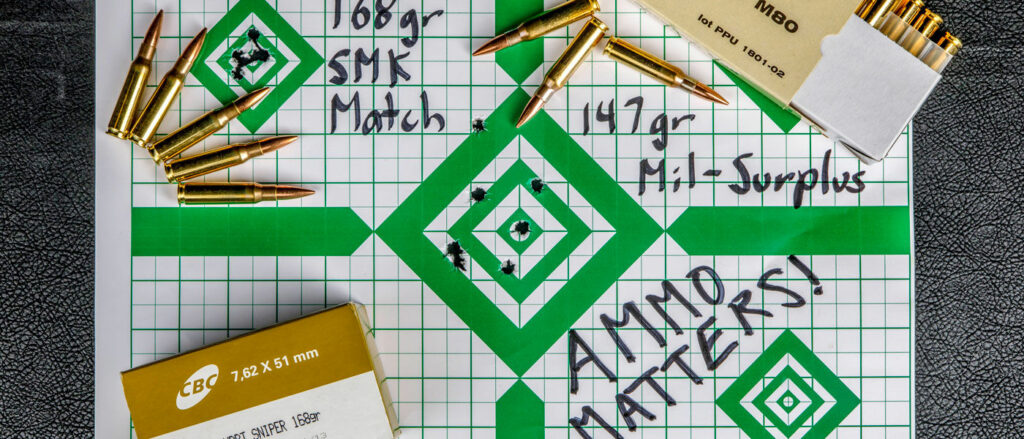
Accurate shooting is essential. If your three shots are spread out in an 8” wide group all around the edges of the target, it’s impossible to make an informed decision about how to adjust your scope. What you are hoping for is three shots reasonably close to each other, all located together somewhere on the target.
The zeroing process should be done with the ammo you intend to use most in that rifle. If you have an ammo type you intend to use for duty, hunting, or competition, sight in using that ammo. Different bullet shapes and weights will shoot differently out of the same gun. Loads that appear identical in theory but are produced by different brands are also likely to perform differently.
If you sight in with cheap gun show reloads and then chamber an expensive hunting round for your deer hunt, you are setting yourself up for heartbreak. If you sight in with true military specification M193 5.56 NATO, and then try taking a 400-yard shot with cheap steel-cased .223 Remington, you’ll miss—guaranteed.
How to Zero a Scope – Computing Adjustment Amounts
It is time to fire your first 3 shot group and start adjusting the elevation and windage knobs. Using your ruler, or by counting the squares printed out on the target itself, measure two distances: the vertical distance from your group straight down to the middle of the target, and the horizontal distance from your group straight across to the middle of the target.
Measuring in a line straight from your group to the center of the target is not helpful, because your scope can only adjust the point of impact vertically and horizontally, not diagonally. Most experienced shooters agree that it is best to adjust in only one direction at a time. Spinning both adjustment knobs simultaneously between firing groups adds more variables and makes tracking down problems more difficult if you don’t get the results you wanted.
At this point many shooters let themselves down by not bothering to do some basic math. They twist both the elevation and windage knobs at the same time “until it feels right” or “just a few clicks” and then shoot again, hoping for improvement. While we know that shooting is the fun part, a more methodical approach is best.
Your scope’s click adjustment value and direction of adjustment are likely indicated on the knobs themselves. If not, you can find them in the user manual or online, but you need to know which way your bullet impact will change and how much. You’ll see an arrow pointing clockwise or counterclockwise, and normally “U” or “UP” on the elevation knob and “R” or “RIGHT” on the windage knob.
Here is a place where shooters get confused by overthinking. These markings indicate change in the bullet’s point of impact. To understand what that really means, take it one step at a time.
1. Keep your scope reticle aimed perfectly in the center of the target with each group you fire.
2. When your bullets hit somewhere else, you need to “steer” them towards the exact center of the target as well.
3. The direction indicated on the scope’s adjustment knobs is the direction that the next shots will go. Ask yourself: “which direction do the bullet holes need to go, and how far, for them to land in the center the next time I fire?” Turn the adjustment knobs in that direction, and that many clicks.
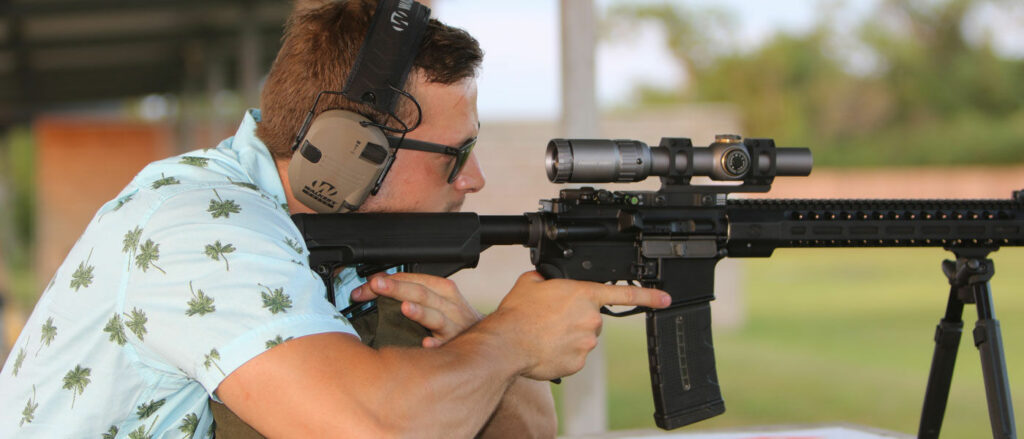
As an example, your first 3-shot group hit 4 inches high and 2 inches right. You decide to adjust only windage first and leave elevation for later. Your group hit to the right, and the knob indicates turning counterclockwise will shift the bullet’s point of impact further to the right.
That’s turning the knob the wrong way, so you need to turn clockwise to shift the impact to the left and send your next group closer to your consistent point of aim in the center.
How many clicks to count? That depends on the click value of the adjustment knob and the distance to target. Click values may be calibrated in either Minutes of Angle (MOA) or Milliradians (MIL or MRAD). Think of MOA as American standard math and MIL as the metric version.
Picking a system and learning it is essential to becoming an accurate long distance shooter, but that Scope University class is next semester. For now, just know that 1 MOA equals roughly 1” at 100 yards, and 1 MIL is 3.6 inches at 100 yards.
We need to understand how far to move the bullet’s point of impact, then translate that into how many MOA or MIL clicks are needed to accomplish that distance.
Example 1: The target is 100 yards away and your scope’s adjustment knobs are labeled 0.5 MOA. Each click will move the bullet’s point of impact 0.5 MOA in the direction indicated. 1 MOA is 1” at 100 yards, so it takes two clicks to move the bullet one inch at that distance. Because the shot group is two inches to the right, turn the knob four clicks clockwise. Easy!
Example 2: The target is 100 yards away and your adjustment knobs are labeled 1/10 MIL. Each click will move the bullet’s point of impact 0.1 MIL in the direction indicated. Ten of those clicks equals 1 MIL (3.6” at 100 yards) so each click moves the bullet’s point of impact .36” at 100 yards.
How many clicks needed to move two inches? Divide 2 by .36 and we get 5.55, or five and a half total clicks. Count either five or six clicks, it’s your call.
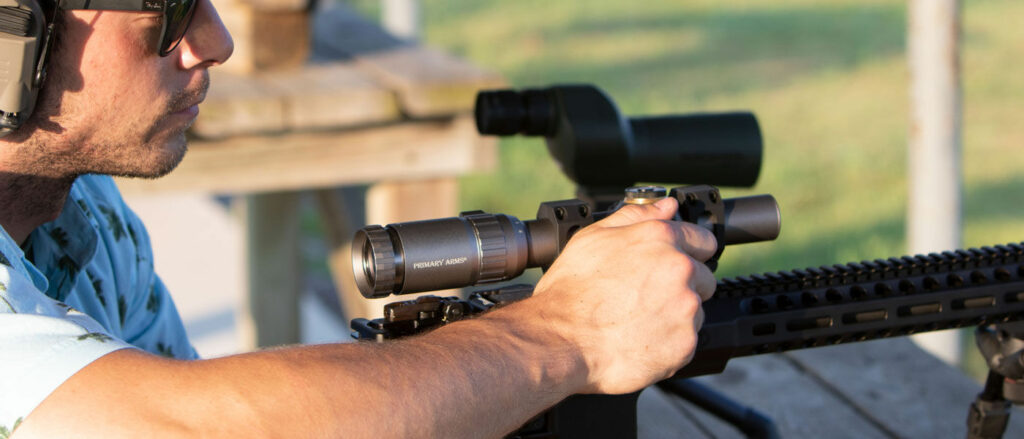
How to Zero a Scope — Zeroing at Other Distances, and Height Over Bore
Zeroing at 50 or 25 yards
What if you don’t have access to a 100 yard range? What if you only have 50 yards available, for example? It isn’t hard to crunch the math if you understand how the MOA and MIL angular units of measure spread out as distance changes.
For every 100 yards distance, MOA will “grow” just slightly over one inch. 1 MOA equals roughly 2” at 200 yards, 3” at 300 yards, and so on. MIL is the same way. If 1 MIL is 3.6” at 100 yards, then it is 7.2” at 200 yards, 10.8” at 300 yards, and so on.
Example 3: The target is 50 yards away and your adjustment knobs are labeled 0.5 MOA. 1 MOA is about half an inch at 50 yards, so two clicks of the adjustment knob will move the bullet’s impact just half an inch instead of one inch. Because your shot group is 2 inches away, at 50 yards the group is 4 MOA from center. 0.5 MOA per click times 4 MOA = 8 clicks clockwise. Putting it another way, because we cut the distance to the target in half, we also cut the effectiveness of our knob’s click values in half.

Example 4: The target is 50 yards away and your adjustment knobs are labeled 1/10 MIL. We can do this! If 1 MIL is 3.6” at 100 yards, then divide that in half – at 50 yards 1 MIL is 1.8”. It will now take ten clicks of this scope to adjust 1.8” at 50 yards.
With your example group two inches to the right, at this point you could say “Hey, 1.8 inches is pretty close to 2 inches, I’m just going to count, uh, nine clicks and shoot my next group.” Quick estimates like that are fine, but how does the math work exactly?
Crunching the numbers out while using MRAD and inches ends up in a headache of ugly algebra equations. The best thing to do is work with 1/10 MIL scopes in their “native language” of meters and centimeters. Translated to metric, your example group needs to shift about 5 cm left, and the 50 yard target is actually 45.7 meters away from the firing line. Now what?
1 MIL covers 10 cm at 100 meters, so 1 MIL covers 4.57 cm at our 45.7 meter target distance. You need to move the point of impact 5 cm left. 4.57 cm divided by 5 cm = your shot group is 0.94 MIL away from center. Choose either nine or ten clicks clockwise on the windage adjustment knob to shift that point of impact .9 or 1.0 MIL to the left.
If you are working in meters and centimeters, remembering that 1 MIL = 10 cm at 100 meters gives you that metric “ten base” system that is really easy to work with once you understand it. Each click of the 1/10 MIL adjustment knob will change your point of impact by 0.5 cm at 50 meters, 1 cm at 100 meters, 2 cm at 200 meters, etc.
With a little practice, it’s easier to run MIL/meters calculations in your head than MOA/inches, but this is the 21st century: using a ballistic calculator phone app like Strelok Pro or Ballistic AE will get you the most precise results regardless of which system you are using.
You can also use a ballistic calculator app to help figure out an “offset” to simulate a 100 yard zero while sighting in at a shorter distance.
A ballistic calculator app can also help you with “height over bore” issues. Elevation adjustments get a bit tricky when zeroing at distances closer than 100 yards using AR15s, AK47s, or other rifles where the optic is mounted significantly higher than the barrel.
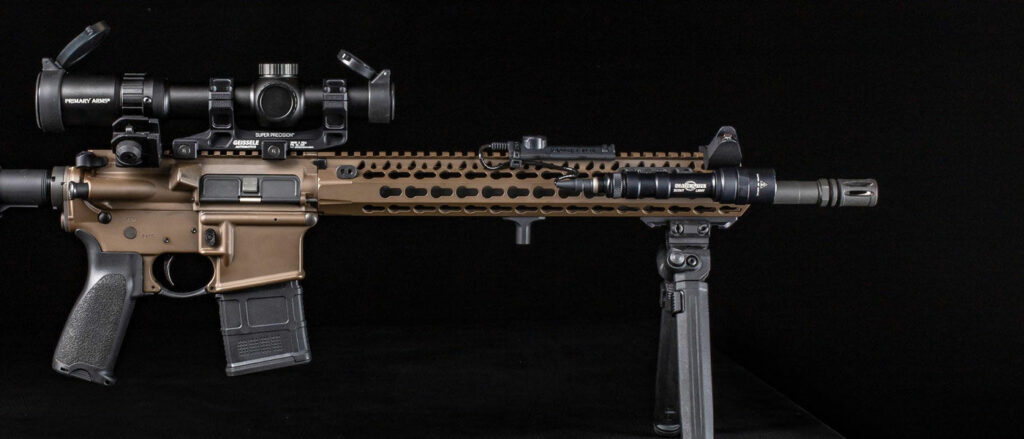
The space between the center of the barrel and the center of the scope crates an angle between the barrel and optic relative to the target. At 100 yards, the angle is pretty minimal and not worth fussing over, but at just 25 yards the angle is significant. The bottom line is, for most AR15 configurations, your point of impact needs to actually be 1.5” BELOW your point of aim at 25 yards to account for the optic sitting so far above the barrel.
If you sight in with your AR15’s bullet point of impact and point of aim perfectly “zeroed” at just 25 yards, at 100 yards your bullet will hit 6” high! The ballistic calculator apps can help you compensate for height over bore at close range. There are custom targets available to assist shooters who have no choice but to sight in their rifles at 25 yards, or you can just draw an X on the target with a marker in the right spot and correct your shot groups to that spot instead of dead center.
Shooting tight groups at 25 yards is relatively easy—at your first opportunity you will want to confirm your adjustments and check your zero at its true distance.
Bonus Zeroing Hack: If you have scope with enough magnification to spot the location of your shot group, and the scope’s reticle incorporates the MIL or MOA systems, you can skip ALL the math regarding inches or centimeters, and the target’s distance doesn’t matter either! Observe your target through the scope and use the reticle to measure the distance between your point of aim and the point of impact in whichever system the reticle uses.
The reticle and the adjustment knobs should be calibrated in the same mathematical system, just note the observed distance through the scope and count out the clicks to shift your point of impact that same number. There are no other measurements or conversions to do because, for example, 2 MOA is still 2 MOA whether the target is 50 yards away or 1000 yards away.

How to Zero a Scope – Point Of Impact Shift
Once you’ve sighted in your rifle’s optic, you shouldn’t just assume that it will always be good to go. There are several factors that can cause your zero to shift. A wise shooter re-checks their zero if any of the following have happened:
1. Significant change in ambient temperature. If it was 95⁰F in August when you zeroed your deer rifle, but the hunting season arrives in November and the temperature has dipped to 25⁰F, you need to re-zero in the weather that you will be hunting in. The metal, polymer, and/or wood components in your rifle setup will expand and contract at different rates as temperature changes, subtly shifting things around.
Even if your rifle itself were somehow not affected by the temperature change at all, the bullet’s trajectory will be different as the gunpowder burn rate changes and the bullet flies through the colder, denser air.
2. Significant change in altitude or weather. Air density, measured by barometric pressure, has a measurable impact on bullet trajectory. A rifle zeroed at sea level needs to have it’s zero confirmed again before you take it on that expensive mountain goat hunt in the Colorado Rockies.
A rifle zeroed under clear skies will experience a small, but measurable difference in trajectory with a big storm looming overhead. Tracking, monitoring and compensating for all these changes is the expertise of the precision rifle shooter—the rest of us just do the best we can!
3. Modification to the rifle. Just bought an awesome new muzzle brake for your AR? Better check your zero after replacing that old A2 flash hider. Different muzzle attachments work by redirecting the gas coming from the muzzle, and some of that gas leaves the barrel ahead of the bullet.
Swapping muzzle devices can certainly change point of impact. Changing the stock in bolt action rifles or changing the handguards on an AR or AK can also change the point of impact. Swapping to a free-floated handguard which utilizes a free floated barrel system, from a previous setup that was not free-floating, will especially affect your point of impact.
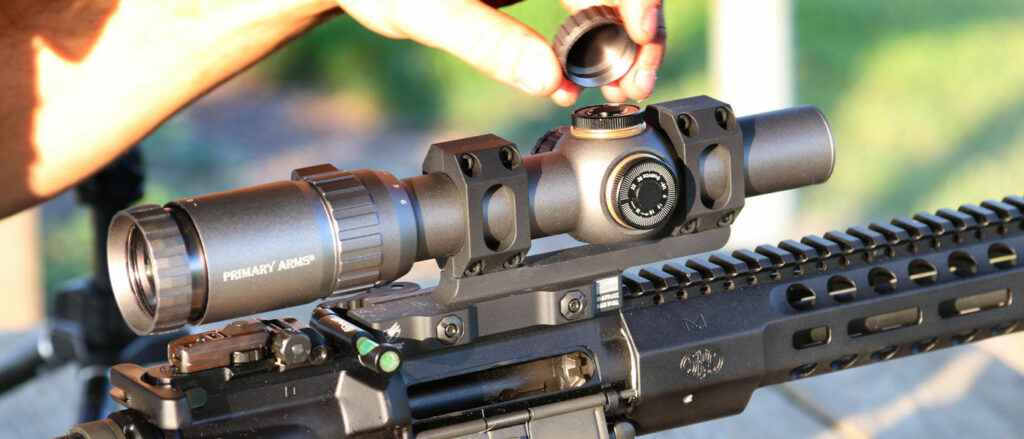
It’s Not Easy Being a Hero
Congratulations! You have all the info you need to go out there and zero your rifle with confidence. But it isn’t easy being a hero. Once your shooting buddies find out you’re the guy who can get their rifle shooting straight with less ammo expended and less time wasted, they’ll be lining up to beg you to help them sight in their favorite rifles as well.
Don’t keep your expertise to yourself—spread the word and teach them what you have learned. They’ll be grateful—shooting sure is a whole lot more fun when you hit your target!
Class… dismissed!



